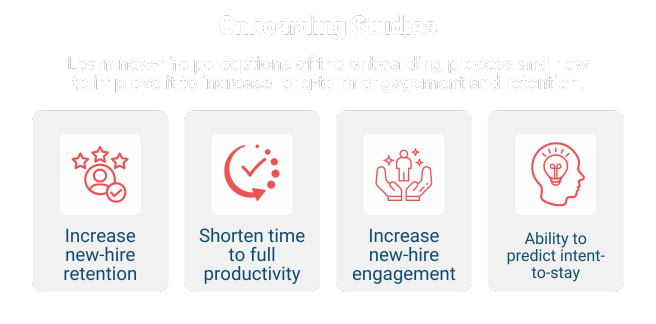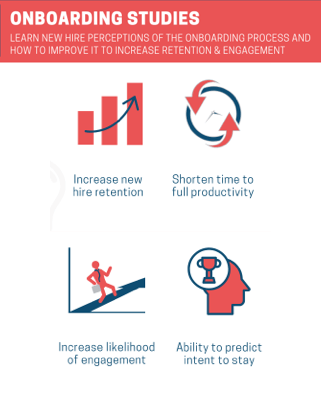Request a Call from our Workforce Experts
GATHERING THE DATA
Conducting Onboarding Studies
Create long-lasting positive employee experiences from an employee’s first day on the job through the insights revealed in Onboarding Studies. Employees who have a great experience in the first 90 days of employment are ten times more likely to stay for a long time than those with a poor experience. Organizations that prepare ahead of time for new employees recognize the value in an organized, well thought-out onboarding process.
Conducted in the right way, Onboarding Studies show new employees they have a voice in the organization, provide data to help improve the onboarding process, and increase engagement & retention.
Objectives of Onboarding Studies
Onboarding Studies are tools through which leaders request feedback from new employees about the new hire process, with the intent of using the information to improve new employee experience. Onboarding Studies specifically help organizations understand what can be improved about the new hire process to help new hires become more productive in their role and better assimilate to the organization.
Objectives of Onboarding Studies include:
- Obtain feedback on the effectiveness of each stage of onboarding
- Uncover insights to improve each stage of onboarding
- Understand attitudes around workplace conditions that drive engagement and retention
- Evaluate the effectiveness of job training elements
- Communicate to employees that their feedback is valued
- Gauge intent to stay with the company
- Reveal potential compliance issues


Keys to Effective Onboarding Studies
It is critical that organizations collect feedback in a way that allows employees to provide open-ended feedback to uncover all possible opportunities at each stage of the onboarding process in order to make meaningful improvements. Effective Onboarding Studies should be conducted using the following criteria:
Ask for feedback at key stages of the onboarding process
To ensure effectiveness, leaders should tailor onboarding surveys to each organization’s unique needs and at the key stage of the onboarding process. For example, feedback could be requested from new-hires after orientation, after the first day, after 30 days, or after 90 days on the job. All organizations are unique in their onboarding process and feedback must be timed where it is most impactful to the process and the organization.
Select an external partner
Onboarding Studies should be conducted through an independent third-part to remove biases and remove barriers to employees feeling they can express their true perceptions related to the onboarding process. When conducted internally, it is likely that true intents and root causes of perceptions aren’t revealed because employees are not being completely honest with the organization. Employees may not want to risk burning a bridge or disappointing a manager. Additionally, data from onboarding studies is systematically collected and thoroughly reported when conducted externally.
Use a mixed methodology approach – Ask “Why?”
Mixed method research instruments ask “why?” in an open-ended, qualitative manner to avoid limiting the scope of what can be learned from each individual employee. Work Institute’s researchers offer high-quality telephonic interviews and web interviews that capture in-depth qualitative responses in a systematic manner. Asking fewer questions and specifically following up to ask why the interviewee responded that way creates in-depth data and reveals the root causes of attitudes. This also helps identify critical action items that must be implemented in the organization to improve engagement.
Gather suggestions to improve processes and the workplace
To understand specific actions that could move new-hires to perceive the onboarding process as “excellent,” it is critical to ask. It is essential to double-probe and solicit multiple responses to understand the most important reasons for rating aspects of the process and know what it would take for the organization to get a top rating. This type of questioning provides details on opportunities to improve the onboarding process and positively impact the organization.
Use quantitative analysis of qualitative data
Qualitative information must be collected systematically, categorized into themes, and quantitatively analyzed. Quantitative analysis is an effective means to reduce bias and maximize casual understanding. This allows organizations to conduct and analyze onboarding data on a large scale. Doing so creates an organizational opportunity to identify the most common themes that can be responsibly acted on to make the most impact.

